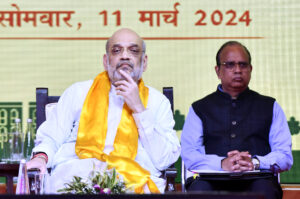Making history – Leisure News
[ad_1]
In pre-colonial Persian works of different genres, India was often referred to as Hindustan, but the word Hindustan almost always existed as a compound phrase, Hindustan Jannat Nishan, that is ‘Hindustan the sign of heaven on earth’. The idea that Hindustan was a special place, not just the greatest country in the world, possibly also the greatest Islamic land in the world, goes back to the time of Amir Khusrau in the 14th century, may be even earlier. This Hindustan Jannat Nishan was celebrated in chronicles, histories, poetic compilations in Persian and in other vernacular languages. These works extolled its climate, its diversity, its produce and its culture. However, this Hindustan, the beloved of pre-colonial histories, has disappeared from modern Indian history writing and has been replaced by the idea of India, and more commonly in the popular imagination, as ‘thousand years of Muslim tyranny and destruction’. How did this come about? In investigating this problematic Manan Ahmed Asif has also written a genealogy of how history has come to be written in modern India. In doing so he reverses the dictum that the oppressed and marginalised pose to hegemonic histories everywhere viz. our past comes in the way of your history. Here the formulation that is more apt is this: it is our history that comes in the way of their past.
They here are the colonial British historians of India, who wrote the first modern histories of India in the 18th and 19th centuries. It is through their formative histories that we have largely come to know our past. But in writing their histories they depended on the very Persian chronicles that they unanimously dismissed with great condescension. Manan’s analysis begins with Alexander Dow, a soldier in the East India Company who published his History of Hindustan translated from the Persian History of Ferishta in 1768. But Dow’s book, and his subsequent works, were far more than translations. Dow also had a thesis on Indian history and on the sources that he used which framed his translations, a thesis shared by his fellow Orientalists such as William James, Alexander Scott, Warren Hastings and others. Muslim rule in India, he claimed, was utterly despotic, which oppressed the original inhabitants of India, the Hindus, who had a glorious past but who entirely lacked a sense of history, and that Muslim histories were mostly useless compilation of facts and conquests. Manan shows how Dow’s ideas were picked up by other influential thinkers in Europe. Dow, who was from Scotland, was a close correspondent of David Hume. Hume introduced Dow’s text to Voltaire and to Immanuel Kant. Voltaire, Kant, Hegel, Schlegel, Herder all of whom gave lectures on the spirit and philosophy of history internalised and propagated these ideas of Indians, that is Hindus as original inhabitants who lacked all sense of history and outsider Muslim invaders who initiated an era of despotism. In his famous tract of 1784 titled ‘Idea for a Universal History‘, Kant asserted that the inhabitants of India did possess a five-thousand-year-old past, but they were, “repeatedly “interrupted” by foreign invaders, and hence were one of the many nations whose past belongs to the terra incognita,” the unknown land of history. Supine Hindus lacking any sense of history, despotic Muslims and both their salvation in British justice, these ‘truths’ became a common-sensical understanding of India. They were also used by these philosophers of history to justify the forcible admission of India, and other colonised spaces, into the march of History.
The native historian that Dow relied upon to present India to the world was Abul Qasim Ferishta, who wrote his monumental history of Hindustan in the Deccan in the early 17th century, at the court of the Ibrahim Adil Shah of Bijapur, the self-acclaimed devotee of Ganesha and Saraswati. Manan
demonstrates how Ferishta was operating self-consciously in a comity of Indo-Persian historians who had gone before him but who also initiated a new way of writing the history of India by beginning his account with the Mahabharata. By investigating Ferishta, and his predecessors, Manan shows that far from being worthless compilation of facts, the medieval chroniclers had an articulate notion of history writing as well as a sophisticated understanding of India’s pre-Muslim pasts. Ferishta wrote a history of India where no religion was privileged over another and where the main ethical task before rulers was to deliver justice and prosperity to their subjects irrespective of faith. He describes a Hindustan that has an excellent climate, wonderful weather, where the diversity of people, races and religions produced polities that are hospitable and accommodative to different faiths and ethnicities. Ferishta’s history was immensely popular as evidenced in the number of manuscripts that survive and also in the number of summaries and derivative histories that it inspired for the next two hundred years, not just in Persian, but also in Urdu, Gujrati, Marathi and Bengali. By dwelling on Ferishta and the community of historians who preceded and succeeded him, Manan shows that the making of the subcontinent as Hindustan was a political and cultural process, which was understood and popularised by a wide variety of literati. The idea of Hindustan existed in legal tracts, in travelogues, in invocation to customs, usages, histories and communities. It was a ‘felt’ community. Hindustan was not just a geographical space, it was also a cultural and social space. This is exemplified in this couplet by a 17th century Irani poet called Salim Quli Khan who stated,
Neest Dar Iran Zameen Saman e Tehseel E Kamaal
Ta Na Aayad Su-e Hindostan Hina Rangeen Na Shud
There is no reward for talent in the land of Iran
Until it travels to India the henna does not bloom
However, the Ferishta that Dow served up to Europe was put to very different uses, which condemned him and his Hindustan to the historical dustbin. The history of Hindustan that Dow presented was a history that demonstrated a Muslim despotism that subjugated the Hindus. In this history of ‘India’ instead of Hindustan, this multi-cultural, open, inclusive, expansive polity was erased and reduced to a confrontation between two irreconcilable and exclusive communities. It also justified British rule in India and provided it a moral sheen. As Dow said in his dedication ‘it would make clear to the British public their moral and ethical superiority over the forms of governance at present in the subcontinent.’ Dow’s history and theses was to be greatly amplified in the next century. In the 1820s James Mill wrote a multi-volume history of India without ever setting foot here, and he was followed by Montstuarte Elphinstone whose immensely popular History of India (divided into Hindu and Mohammedan periods) set the template for much of history writing in India in the second half of the nineteenth century through its many translations into Indian languages. These efforts were crowned by Henry Elliot’s posthumous 8 volume The History of India as Told by Its Own Historians in the 1860s, who chose some 231 Persian histories as representative histories out of the extant 15000 or so, even while being highly contemptuous of their efforts. These works entrenched the idea of a timeless Hindu past and a ceaseless Muslim despotism. This colonial framing of Indian history in turn came to inform our own understanding of our past. It has, in turn, compelled many shades of Indians to seek a more muscular present. In this knowledge certain ‘facts’ have become naturalised, as if they have existed since eternity. For instance, the related ideas of a Hindu “Golden Age,” featuring a majestic and quietist Hindu polity with its monumental Sanskrit
epics, and the barbaric Muslim “invader” kings, who pushed India into darkness by their forced conversions, temple destructions and pillage. These facts have acquired an incantatory power, where the mere mention of one implies the other. As Manan says, “the five thousand years, the Golden Age of Ashoka, the seventeen raids of Mahmud Ghazni, and Muslim despotism, this is the central logic in the philosophy of history that has organized the colonized historiography of Hindustan.”
The religious and territorial wars of the 17th and 18th centuries convinced many Europeans of the virtues of Nationalism, which implied that one country means one people, one religion and one language. Nations, it was assumed, must have a national past. Therefore Nations needed histories which justify their existence. Before this time, “history” had connoted a story or narrative, such as an account of a battle or journey. But in the 18th century history became a moral field, a justification for the present and a guide not just to the past but also to the future. The European understanding of India therefore was predicated upon religion and language as being the key identifiers of a nation. It was also informed by the Crusades and their long history of violent conflict with Islamic lands. As they sought, so they found India to be anything but a nation. And following this ceaseless interrogation, and condemnation, Indians, schooled in European history, sought to forge their own virile nationalities via their languages, ethnicities and numbers. By the time of Partition, the colonial narrative about Muslim foreignness and the past five hundred years of the subcontinent as representative of despotism and decay had been so internalised that it cut across the political divide: Ambedkar, Savarkar, Jinnah, all shared the underlying logic of these divisions, with varying emphases. The Italian statesman Massimo d’Azeglio is supposed to have remarked after the unification of Italy in the 19th century that “We have made Italy. Now we must make Italians.” Indian nationalism was faced with a similar problem, there were Hindus and Muslims galore but not enough Indians in its past. The way India had been narrated, has been narrated, it has been easier to make Hindus and Muslims of Hindustanis than to make Indians out of them.
The idea of Hindustan did not disappear in the 20th century. It survived in the many anti-British Hindustani Sabhas abroad and in Chandrashekhar Azad and Bhagat Singh’s the Hindustani Socialist Republican Party. It survived in Gandhi’s attempt to posit Hindustani as a language which he presented as a solution to the internecine wars between Urdu and Hindu. Manan takes us to the struggle of the modern Indian historians of the 20th century, in places such as Allahabad, Aligarh, Lahore and Calcutta who challenged this understanding of Indian history through admirable and industrious scholarship. But these efforts have not permeated popular consciousness because even local memory has been shaped by colonial Gazetteers. In his landmark and poignant address to the nationalist Indian History Congress soon after the carnage of Partition, Mohammed Habib, a doyen of 20th century historiography quoted a Persian writer to say that “History is quickly exported from the academy to the bazar and shopkeepers, who cannot distinguish white from black and black from white, [and] confidently venture to pass judgements on historical matters.” In the modern Indian subcontinent, the radical difference between Hindus as insiders and Muslims as outsiders is one such naturally felt history of the bazars, but one which has also significantly shaped disciplinary history and popular understanding and mythmaking. Hindustan, asserted the medieval chroniclers, was wonderful because it belonged to everyone. But our awareness of that past is now mediated and shaped through the self-serving colonial knowledge-making machinery about India. Manan’s thoughtful, penetrating and subtle book reminds us that the forging of modern India may have involved counterfeiting some currencies about our past.
Mahmood Farooqui is a Delhi based writer best known for reviving Dastangoi, the lost Art of Urdu storytelling. His last book was A Requiem for Pakistan: The World of Intizar Husain (Yoda, 2017).
[ad_2]
Source link







